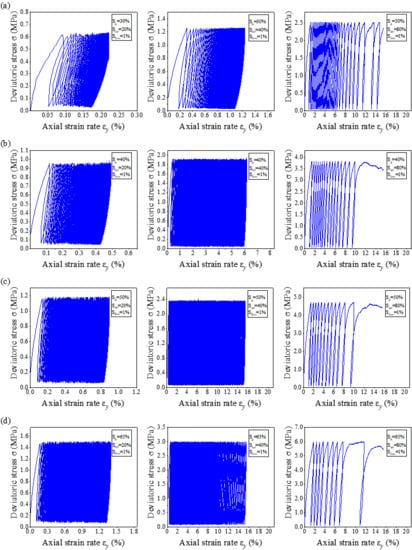The Distinct Elemental Analysis of the Microstructural Evolution of a Methane Hydrate Specimen under Cyclic Loading Conditions
Abstract
1. Introduction
2. Numerical MHS Models with Different Levels of Hydrate Saturation
2.1. Particle Flow Code (PFC)
2.2. Parameter Checking and the Verification of MHS
3. Numerical Simulation Results’ Analyses
3.1. Macro-Mechanical Results
3.1.1. The Relationship between Dynamic Stress and Strain
3.1.2. The Relationship of Strain versus Cyclic Time
3.2. Micro-Mechanical Results
3.2.1. Coordination Number Evolution
3.2.2. Contact Normal Fabric Evolution
3.2.3. Stress–Force–Fabric Relationship
4. Conclusions
Author Contributions
Funding
Conflicts of Interest
References
- Makogon, Y.; Omelchenko, R.Y. Engineering. Commercial gas production from Messoyakha deposit in hydrate conditions. J. Nat. Gas Sci. Eng. 2013, 11, 1–6. [Google Scholar] [CrossRef]
- Kurihara, M.; Funatsu, K.; Ouchi, H.; Masuda, Y.; Yamamoto, K.; Narita, H.; Dallimore, S.R.; Collett, T.S.; Hancock, S.H. Analyses of production tests and MDT tests conducted in Mallik and Alaska methane hydrate reservoirs: What can we learn from these well tests? In Proceedings of the the 6th International Conference of Gas Hydrates, Vancouver, BC, Canada, 6–10 July 2008. [Google Scholar]
- Fujii, T.; Suzuki, K.; Takayama, T.; Tamaki, M.; Komatsu, Y.; Konno, Y.; Yoneda, J.; Yamamoto, K.; Nagao, J.J.M.; Geology, P. Geological setting and characterization of a methane hydrate reservoir distributed at the first offshore production test site on the Daini-Atsumi Knoll in the eastern Nankai Trough, Japan. Mar. Pet. Geol. 2015, 66, 310–322. [Google Scholar] [CrossRef]
- Tanigawa, K.; Shishikura, M.; Fujiwara, O.; Namegaya, Y.; Matsumoto, D.J.T.H. Mid-to late-Holocene marine inundations inferred from coastal deposits facing the Nankai Trough in Nankoku, Kochi Prefecture, southern Japan. Holocene 2018, 28, 867–878. [Google Scholar] [CrossRef]
- Li, J.-f.; Ye, J.-l.; Qin, X.-w.; Qiu, H.-j.; Wu, N.-y.; Lu, H.-l.; Xie, W.-w.; Lu, J.-a.; Peng, F.; Xu, Z.-q.J.C.G. The first offshore natural gas hydrate production test in South China Sea. China Geol. 2018, 1, 5–16. [Google Scholar] [CrossRef]
- Shouwei, Z.; Qingping, L.; Wei, C.; Jianliang, Z.; Weixin, P.; Yufa, H.; Xin, L.; Liangbin, X.; Qiang, F.; Jiang, L. The World’s First Successful Implementation of Solid Fluidization Well Testing and Production for Non-Diagenetic Natural Gas Hydrate Buried in Shallow Layer in Deep Water. In Proceedings of the Offshore Technology Conference, Houston, TX, USA, 30 April–3 May 2018. [Google Scholar]
- Winters, W.J.; Waite, W.F.; Mason, D.; Gilbert, L.; Pecher, I. Methane gas hydrate effect on sediment acoustic and strength properties. J. Pet. Sci. Eng. 2007, 56, 127–135. [Google Scholar] [CrossRef]
- Priest, J.A.; Druce, M.; Roberts, J.; Schultheiss, P.; Nakatsuka, Y.; Suzuki, K. PCATS Triaxial: A new geotechnical apparatus for characterizing pressure cores from the Nankai Trough, Japan. Mar. Pet. Geol. 2015, 66, 460–470. [Google Scholar] [CrossRef]
- Yoneda, J.; Masui, A.; Konno, Y.; Jin, Y.; Egawa, K.; Kida, M.; Ito, T.; Nagao, J.; Tenma, N. Mechanical properties of hydrate-bearing turbidite reservoir in the first gas production test site of the Eastern Nankai Trough. Mar. Pet. Geol. 2015, 66, 471–486. [Google Scholar] [CrossRef]
- Yoneda, J.; Masui, A.; Konno, Y.; Jin, Y.; Kida, M.; Katagiri, J.; Nagao, J.; Tenma, N. Pressure-core-based reservoir characterization for geomechanics: Insights from gas hydrate drilling during 2012–2013 at the eastern Nankai Trough. Mar. Pet. Geol. 2017, 86, 1–16. [Google Scholar] [CrossRef]
- Priest, J.A.; Clayton, C.R.; Rees, E.V. Potential impact of gas hydrate and its dissociation on the strength of host sediment in the Krishna–Godavari Basin. Mar. Pet. Geol. 2014, 58, 187–198. [Google Scholar] [CrossRef]
- Masui, A.; Haneda, H.; Ogata, Y.; Aoki, K. The effect of saturation degree of methane hydrate on the shear strength of synthetic methane hydrate sediments. In Proceedings of the 5th International Conference on Gas Hydrates, Trondheim, Norway, 13–16 June 2005; pp. 657–663. [Google Scholar]
- Miyazaki, K.; Masui, A.; Sakamoto, Y.; Tenma, N.; Yamaguchi, T. Effect of confining pressure on triaxial compressive properties of artificial methane hydrate bearing sediments. In Proceedings of the Offshore Technology Conference, Houston, TX, USA, 3–6 May 2010. [Google Scholar]
- Miyazaki, K.; Masui, A.; Tenma, N.; Ogata, Y.; Aoki, K.; Yamaguchi, T.; Sakamoto, Y. Study on mechanical behavior for methane hydrate sediment based on constant strain-rate test and unloading-reloading test under triaxial compression. Int. J. Offshore Polar Eng. 2010, 20, 61–67. [Google Scholar]
- Hyodo, M.; Li, Y.; Yoneda, J.; Nakata, Y.; Yoshimoto, N.; Kajiyama, S.; Nishimura, A.; Song, Y. A comparative analysis of the mechanical behavior of carbon dioxide and methane hydrate-bearing sediments. Am. Mineral. 2014, 99, 178–183. [Google Scholar] [CrossRef]
- Hyodo, M.; Li, Y.; Yoneda, J.; Nakata, Y.; Yoshimoto, N.; Nishimura, A. Effects of dissociation on the shear strength and deformation behavior of methane hydrate-bearing sediments. Mar. Pet. Geol. 2014, 51, 52–62. [Google Scholar] [CrossRef]
- Hyodo, M.; Li, Y.; Yoneda, J.; Nakata, Y.; Yoshimoto, N.; Nishimura, A.; Song, Y. Mechanical behavior of gas strength and deformation behavior of methane. J. Geophys. Res. Solid Earth 2013, 118, 5185–5194. [Google Scholar] [CrossRef]
- Hyodo, M.; Nakata, Y.; Yoshimoto, N.; Yoneda, J. Shear strength of methane hydrate bearing sand and its deformation during dissociation of methane hydrate. In Proceedings of the 4th International Symposium on Deformation Characteristics of Geomaterials, Atlanta, GA, USA, 15 September 2008; pp. 549–556. [Google Scholar]
- Hyodo, M.; Yoneda, J.; Yoshimoto, N.; Nakata, Y. Mechanical and dissociation properties of methane hydrate-bearing sand in deep seabed. Soils Found. 2013, 53, 299–314. [Google Scholar] [CrossRef]
- Miyazaki, K.; Masui, A.; Sakamoto, Y.; Aoki, K.; Tenma, N.; Yamaguchi, T. Triaxial compressive properties of artificial methane-hydrate-bearing sediment. J. Geophys. Res. Solid Earth 2011, 116, 1–11. [Google Scholar] [CrossRef]
- Li, Y.; Song, Y.; Liu, W.; Yu, F.; Wang, R.; Nie, X. Analysis of mechanical properties and strength criteria of methane hydrate-bearing sediments. Int. J. Offshore Polar Eng. 2012, 22, 290–296. [Google Scholar]
- Liu, Z.; Wei, H.; Peng, L.; Wei, C.; Ning, F. An easy and efficient way to evaluate mechanical properties of gas hydrate-bearing sediments: The direct shear test. J. Pet. Sci. Eng. 2017, 149, 56–64. [Google Scholar] [CrossRef]
- Kajiyama, S.; Wu, Y.; Hyodo, M.; Nakata, Y.; Nakashima, K.; Yoshimoto, N. Experimental investigation on the mechanical properties of methane hydrate-bearing sand formed with rounded particles. J. Nat. Gas Sci. Eng. 2017, 45, 96–107. [Google Scholar] [CrossRef]
- Kajiyama, S.; Nishimura, A.; Hyodo, M. Shear Behaviour and Localized Deformation of Methane Hydrate-Bearing Sand using High Pressure Plane Strain Shear Tests. In Proceedings of the Eleventh Ocean Mining and Gas Hydrates Symposium, Kona, HI, USA, 21–27 June 2015. [Google Scholar]
- Gong, B.; Jiang, Y.; Chen, L.J. Feasibility investigation of the mechanical behavior of methane hydrate-bearing specimens using the multiple failure method. J. Nat. Gas Sci. Eng. 2019, 69, 102915. [Google Scholar] [CrossRef]
- Mienert, J.; Vanneste, M.; Bünz, S.; Andreassen, K.; Haflidason, H.; Sejrup, H.P.J.M.; Geology, P. Ocean warming and gas hydrate stability on the mid-Norwegian margin at the Storegga Slide. Mar. Pet. Geol. 2005, 22, 233–244. [Google Scholar] [CrossRef]
- Sultan, N.; Cochonat, P.; Foucher, J.-P.; Mienert, J. Effect of gas hydrates melting on seafloor slope instability. Mar. Geol. 2004, 213, 379–401. [Google Scholar] [CrossRef]
- Wright, S.; Rathje, E.M.J.P.; Geophysics, A. Triggering mechanisms of slope instability and their relationship to earthquakes and tsunamis. Pure Appl. Geophys. 2003, 160, 1865–1877. [Google Scholar] [CrossRef]
- Tappin, D.R.; Matsumoto, T.; Watts, P.; Satake, K.; McMurtry, G.M.; Matsuyama, M.; Lafoy, Y.; Tsuji, Y.; Kanamatsu, T.; Lus, W.J.E.; et al. Sediment slump likely caused 1998 Papua New Guinea tsunami. Eos Trans. Am. Geophys. Un. 1999, 80, 329–340. [Google Scholar] [CrossRef]
- Kawata, Y.; Benson, B.C.; Borrero, J.C.; Borrero, J.L.; Davies, H.L.; de Lange, W.P.; Imamura, F.; Letz, H.; Nott, J.; Synolakis, C.E.J.E.; et al. Tsunami in Papua New Guinea was as intense as first thought. Eos Trans. Am. Geophys. Un. 1999, 80, 101–105. [Google Scholar] [CrossRef]
- Erdik, M. Report on 1999 Kocaeli and Düzce (Turkey) Earthquakes; Boğaziçi Üniversitesi, Kandilli Rasathanesi ve Deprem Araştirma Enstitüsü: Istanbul, Turkey, 2000. [Google Scholar]
- Clayton, C.; Priest, J.; Best, A.J.G. The effects of disseminated methane hydrate on the dynamic stiffness and damping of a sand. Geotechnique 2005, 55, 423–434. [Google Scholar] [CrossRef]
- Priest, J.A.; Best, A.I.; Clayton, C.R. Attenuation of seismic waves in methane gas hydrate-bearing sand. Geophys. J. Int. 2006, 164, 149–159. [Google Scholar] [CrossRef]
- Kingston, E.; Clayton, C.; Priest, J.; Best, A. Effect of grain characteristics on the behaviour of disseminated methane hydrate bearing sediments. In Proceedings of the 6th International Conference on Gas Hydrates (ICGH 2008), Vancouver, BC, Canada, 6–10 July 2008. [Google Scholar]
- Lee, J.; Francisca, F.M.; Santamarina, J.C.; Ruppel, C. Parametric study of the physical properties of hydrateed methansand, silt, and clay sediments: 2. Small-strain mechanical properties. J. Geophys. Res. Solid Earth 2010, 115, 1–11. [Google Scholar]
- Zhang, X.; Lu, X.; Wang, S.; Li, Q.J.R.S.M. Experimental study of static and dynamic properties of tetrahydrofuran hydrate-bearing sediments. Rock Soil Mech. 2011, 32, 303–308. [Google Scholar]
- Cundall, P.A.; Strack, O.D.J.g. A discrete numerical model for granular assemblies. Geotechnique 1979, 29, 47–65. [Google Scholar] [CrossRef]
- Cho, N.a.; Martin, C.; Sego, D.J.I.J.o.R.M.; Sciences, M. A clumped particle model for rock. Int. J. Rock Mech. Min. Sci. 2007, 44, 997–1010. [Google Scholar] [CrossRef]
- Castro-Filgueira, U.; Alejano, L.; Arzúa, J.; Ivars, D.M.J.P.e. Sensitivity analysis of the micro-parameters used in a PFC analysis towards the mechanical properties of rocks. Procedia Eng. 2017, 191, 488–495. [Google Scholar] [CrossRef]
- Cao, R.-h.; Cao, P.; Lin, H.; Pu, C.-z.; Ou, K.J.R.M.; Engineering, R. Mechanical behavior of brittle rock-like specimens with pre-existing fissures under uniaxial loading: Experimental studies and particle mechanics approach. Rock Mech. Rock Eng. 2016, 49, 763–783. [Google Scholar] [CrossRef]
- Yang, S.-Q.; Huang, Y.-H.; Jing, H.-W.; Liu, X.-R.J.E.G. Discrete element modeling on fracture coalescence behavior of red sandstone containing two unparallel fissures under uniaxial compression. Eng. Geol. 2014, 178, 28–48. [Google Scholar] [CrossRef]
- Jiang, Y.; Gong, B. Discrete-element numerical modelling method for studying mechanical response of methane-hydrate-bearing specimens. Mar. Georesources Geotechnol. 2019, 38, 1–15. [Google Scholar] [CrossRef]
- Masui, A.; Haneda, H.; Ogata, Y.; Aoki, K. Triaxial Compression test on submarine sediment containing methane hydrate in deep sea off the coast off Japan. In Proceedings of the 41st Annual Conference, Japanese Geotechnical Society, Tokyo, Japan, 9–13 November 2015. [Google Scholar]
- De Alba, P.; Chan, C.K.; Seed, H.B. Determination of Soil Liquefaction Characteristics by Large-Scale Laboratory Tests; Shannon & Wilson: Seattle, DC, USA, 1976; Volume 27. [Google Scholar]
- Seed, H.B.; Idriss, I.M.J.J.o.S.M.; Div, F. Simplified procedure for evaluating soil liquefaction potential. J. Soil Mech. Found. Division 1971, 97, 1249–1273. [Google Scholar]
- Jiang, M.; Zhang, A.; Li, T. Distinct element analysis of the microstructure evolution in granular soils under cyclic loading. Granul. Matter 2019, 21, 38–53. [Google Scholar] [CrossRef]
- Wan, R.G.; Guo, P.J.J.J.o.E.M. Stress dilatancy and fabric dependencies on sand behavior. J. Eng. Mech. 2004, 130, 635–645. [Google Scholar] [CrossRef]
- Satake, M. Fabric tensor in granular materials. In Proceedings of the IUTAM Conference on Deformation and Flow of Granular Materials, Delft, the Netherlands, 31 August–3 September 1982; pp. 63–68. [Google Scholar]
- Oda, M.J.S. Initial fabrics and their relations to mechanical properties of granular material. Soils Found. 1972, 12, 17–36. [Google Scholar] [CrossRef]
- O’Sullivan, C.; Cui, L.J.P.T. Micromechanics of granular material response during load reversals: Combined DEM and experimental study. Powder Technol. 2009, 193, 289–302. [Google Scholar] [CrossRef]
- Cambou, B.; Dubujet, P.; Nouguier-Lehon, C. Anisotropy in granular materials at different scales. Mech. Mater. 2004, 36, 1185–1194. [Google Scholar] [CrossRef]
- Gong, J.; Liu, J.J.C. Mechanical transitional behavior of binary mixtures via DEM: Effect of differences in contact-type friction coefficients. Comput. Geotech. 2017, 85, 1–14. [Google Scholar] [CrossRef]
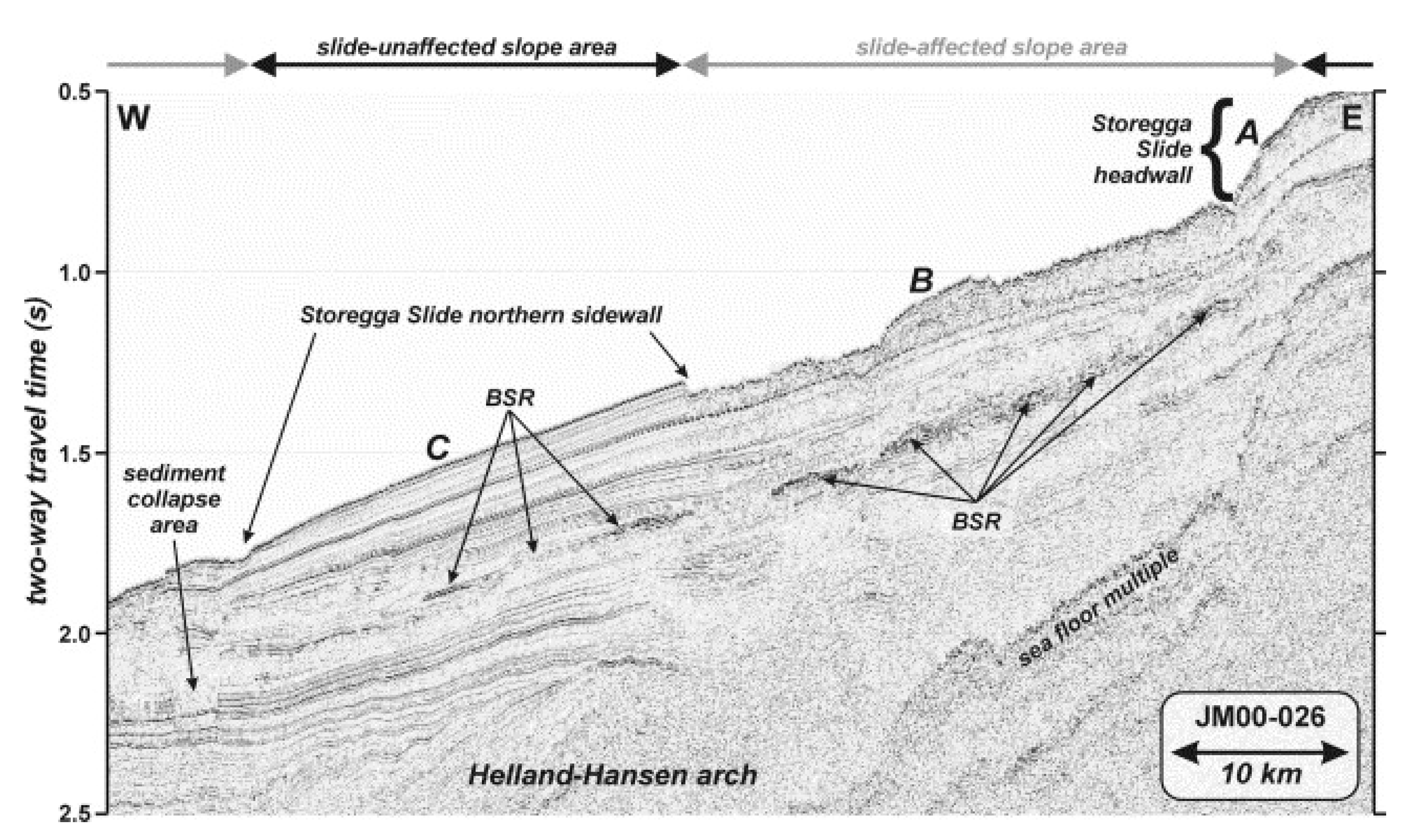

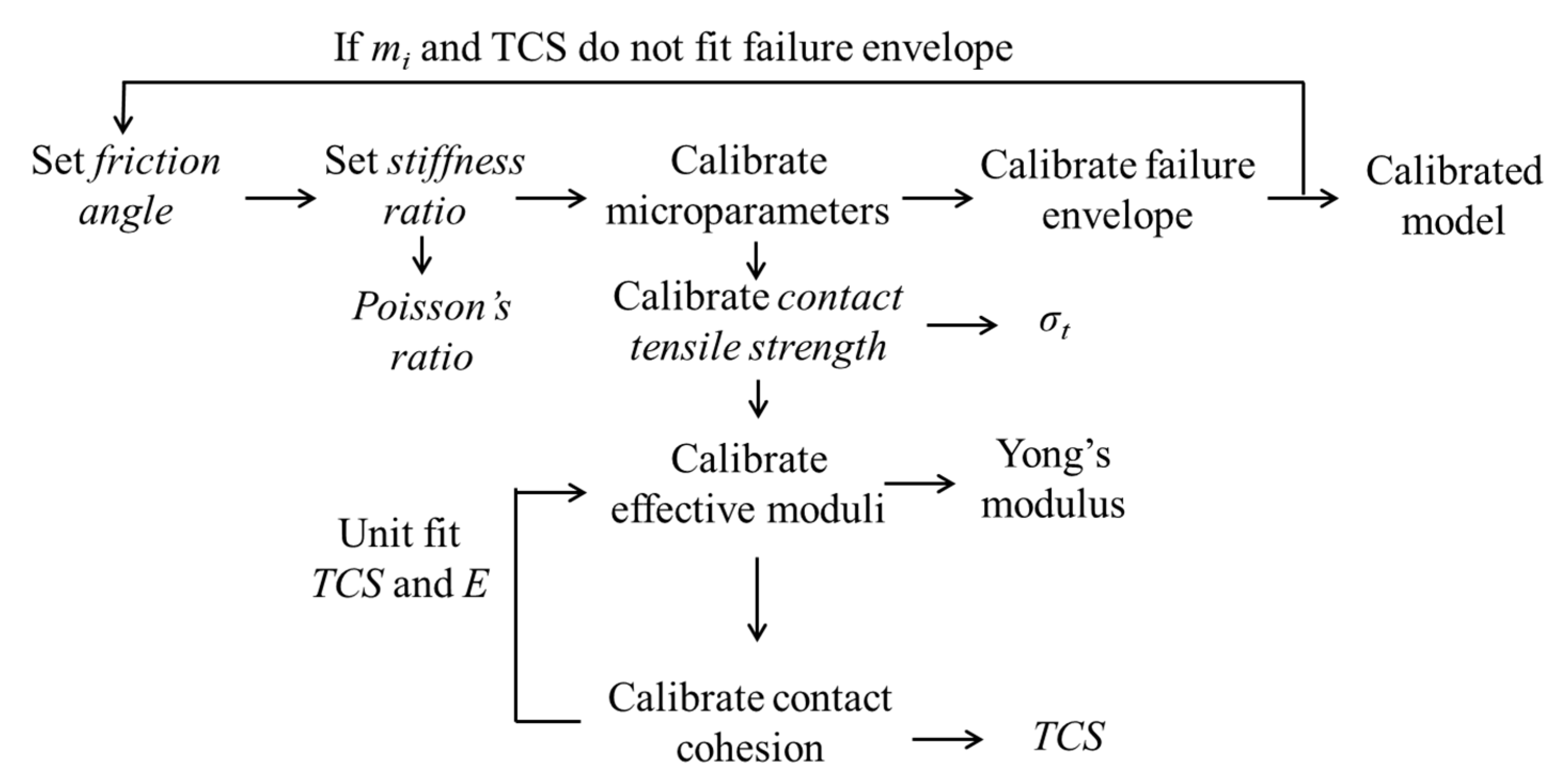



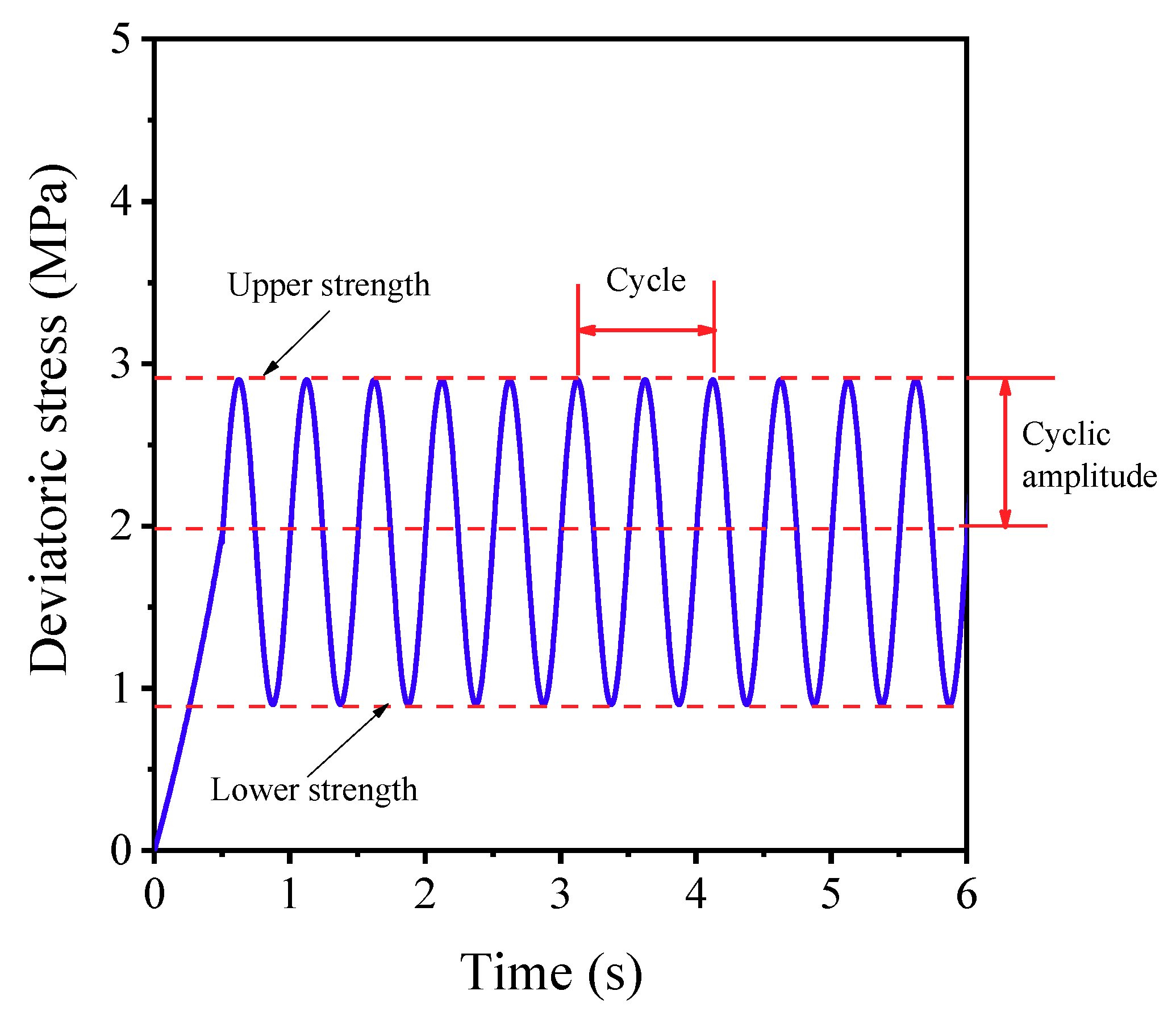
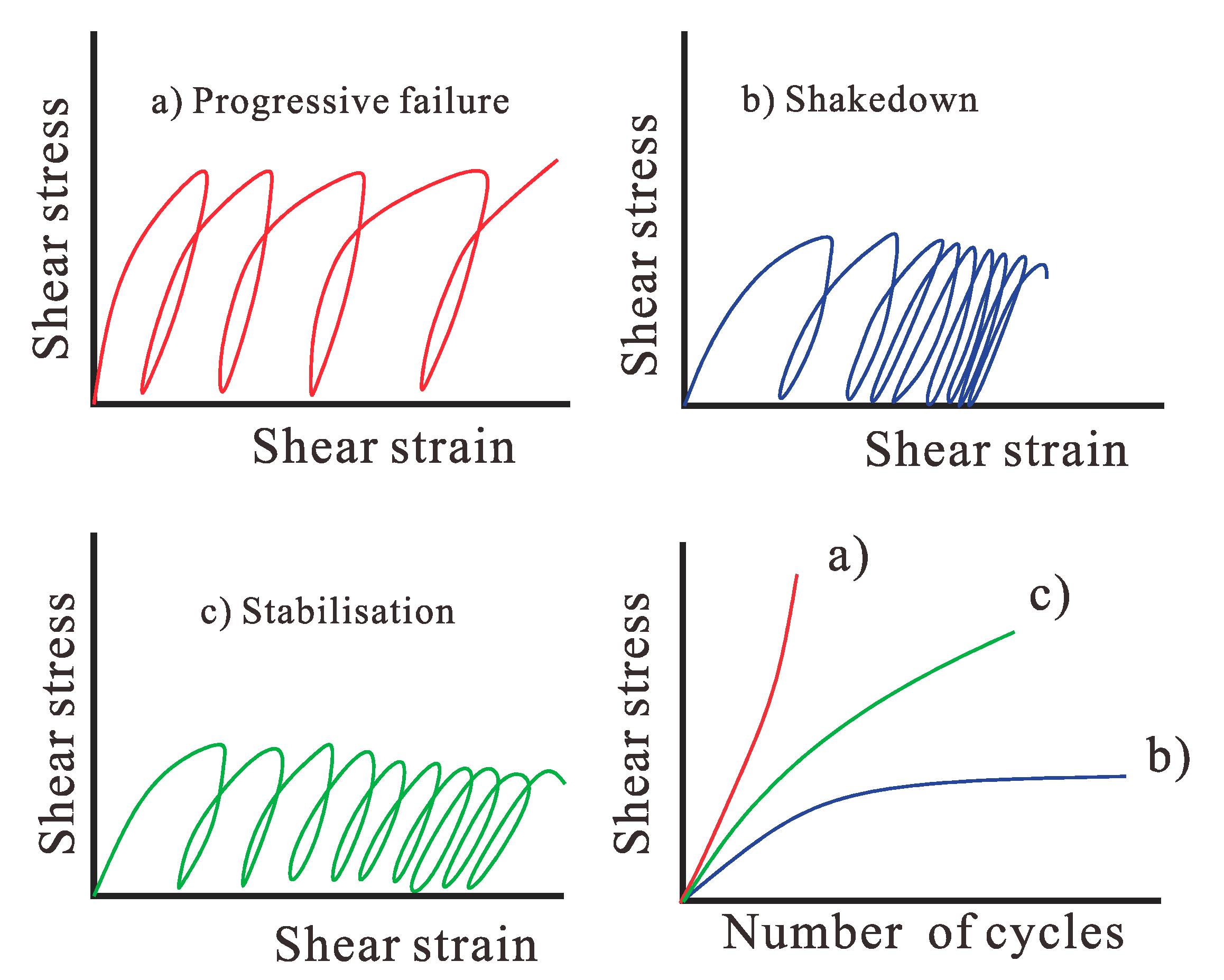

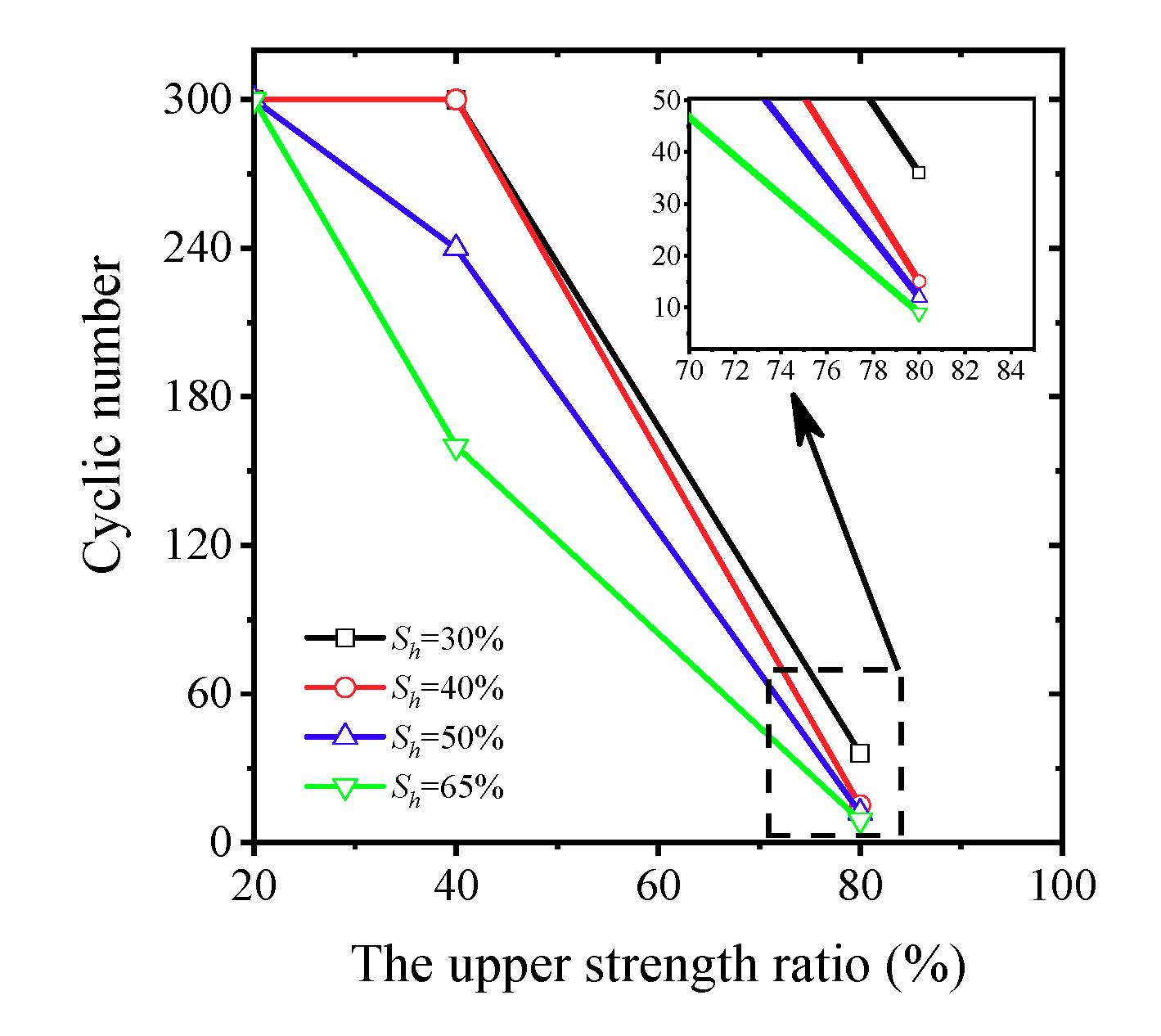
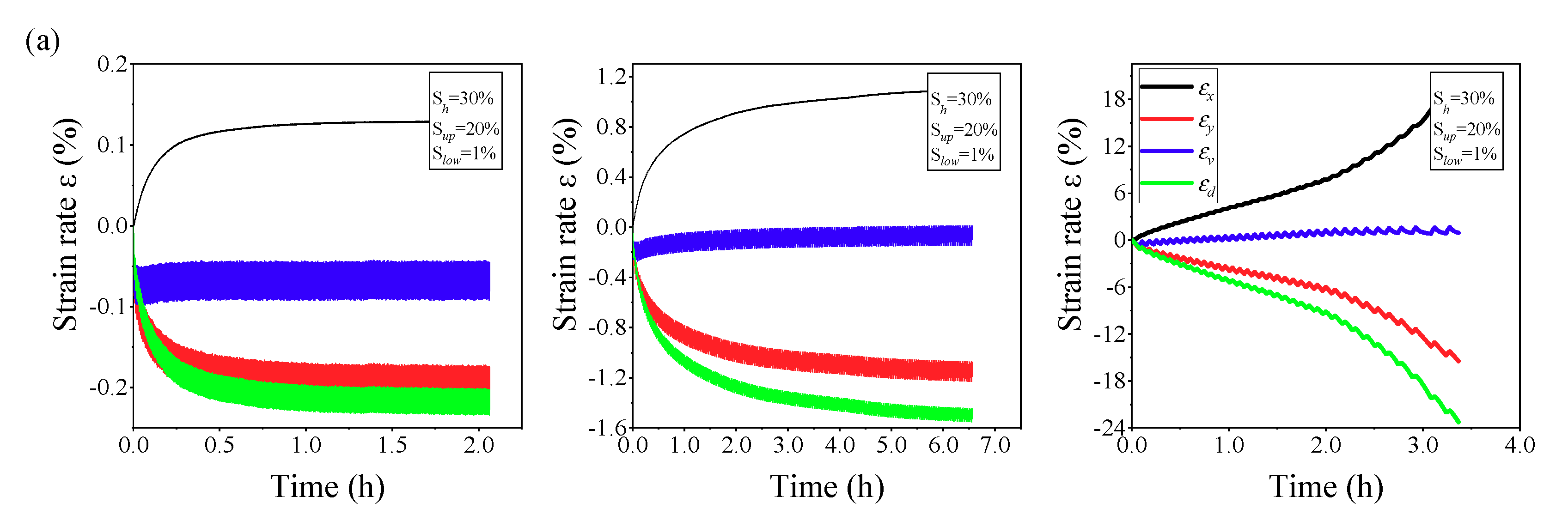

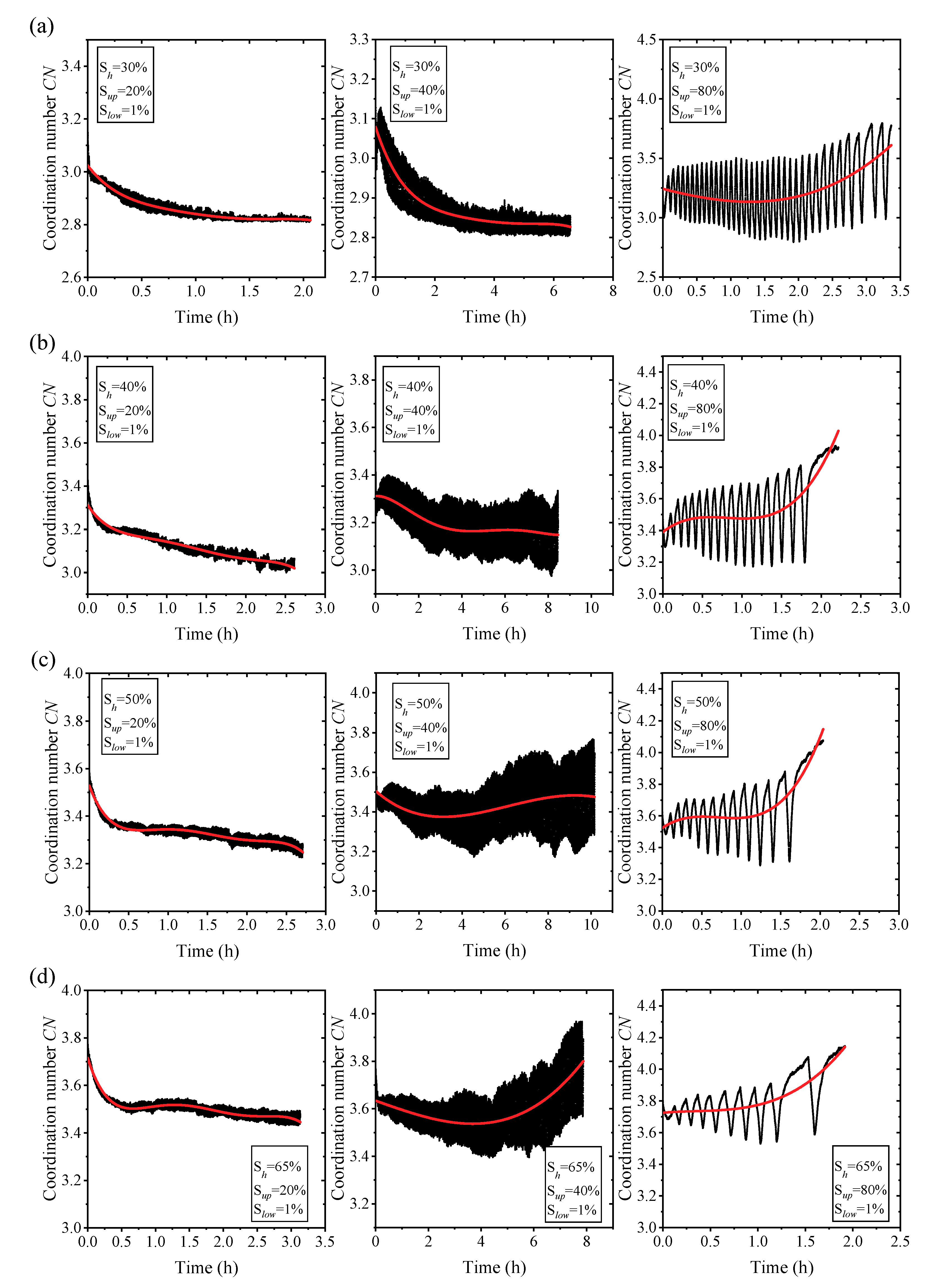


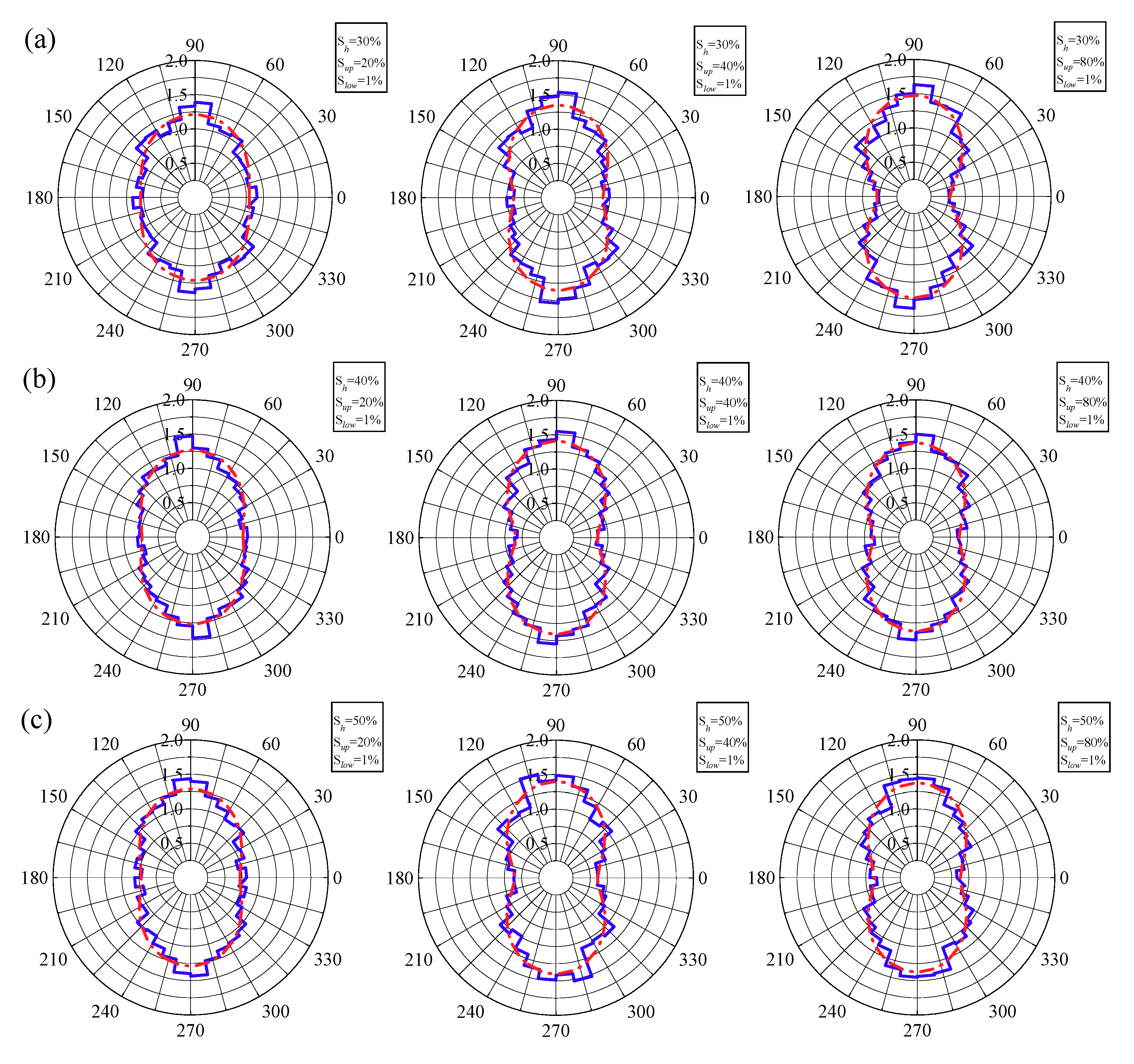


| Property | Soil | Methane Hydrate |
|---|---|---|
| Density (kg/m3) | 2500 | 320 |
| Particle sizes, D (mm) | 0.01–0.4 | 0.006 |
| Normal stiffness kn (N/m) | 1 × 108 | 1 × 105 |
| Shear stiffness ks (N/m) | 1 × 108 | 1 × 105 |
| Inter-particle friction μ | 0.7 | 0.75 |
| Property | Soil–Hydrate | Soil–Soil | Hydrate–Hydrate |
|---|---|---|---|
| Friction μ | 0.15 | 0.5 | 0.15 |
| Normal stiffness kn (N/m) | 1 × 105 | 3 × 108 | 1 × 105 |
| Shear stiffness ks (N/m) | 1 × 104 | 3 × 107 | 1 × 104 |
| Tension strength (N) | 3 × 106 | 3 × 106 | |
| Cohesion (N) | 5 × 106 | 5 × 106 | |
| Friction angle | 10 | 10 | |
| Rolling resistance coefficient (μr) | 0.6 | ||
| Hydrate Saturation (%) | 30 | 40 | 50 | 65 |
| Peak strength (MPa) | 3.16 | 4.93 | 5.91 | 7.52 |
| Upper strength ratio (%) | 20 40 80 | 20 40 80 | 20 40 80 | 20 40 80 |
| Lower strength ratio (%) | 1 | |||
| Frequency (Hz) | 2 | |||
© 2019 by the authors. Licensee MDPI, Basel, Switzerland. This article is an open access article distributed under the terms and conditions of the Creative Commons Attribution (CC BY) license (http://creativecommons.org/licenses/by/4.0/).
Share and Cite
Wang, D.; Gong, B.; Jiang, Y. The Distinct Elemental Analysis of the Microstructural Evolution of a Methane Hydrate Specimen under Cyclic Loading Conditions. Energies 2019, 12, 3694. https://doi.org/10.3390/en12193694
Wang D, Gong B, Jiang Y. The Distinct Elemental Analysis of the Microstructural Evolution of a Methane Hydrate Specimen under Cyclic Loading Conditions. Energies. 2019; 12(19):3694. https://doi.org/10.3390/en12193694
Chicago/Turabian StyleWang, Dong, Bin Gong, and Yujing Jiang. 2019. "The Distinct Elemental Analysis of the Microstructural Evolution of a Methane Hydrate Specimen under Cyclic Loading Conditions" Energies 12, no. 19: 3694. https://doi.org/10.3390/en12193694
APA StyleWang, D., Gong, B., & Jiang, Y. (2019). The Distinct Elemental Analysis of the Microstructural Evolution of a Methane Hydrate Specimen under Cyclic Loading Conditions. Energies, 12(19), 3694. https://doi.org/10.3390/en12193694





